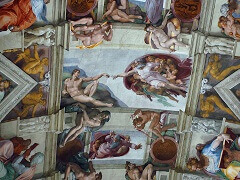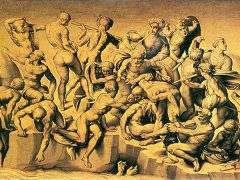The Separation of the Earth from the Waters by Michelangelo

The Separation of the Earth from the Waters is the third painting in the series on Creation by Michelangelo inside the Sistine Chapel. A divergent meaning has been read into this fresco by the earlier biographers, Condivi and Vasari. The spirit of God with the heavenly host moves above the waters; so they thought in terms of the creation of the great Sea Monster. But the main emphasis is on the moving ('ferabatur super aqua' in Saint Jerome) and the hallowing gesture; the title 'God Blesses the World' is indicated. If we consider further that the creative spirit advances from the great depth of space suggested by his mantle, which is formed like a gigantic shell, we come to think of the Waters of the Abyss and the emanation of soul substance, frequently described as a watery element in the mythologies and metaphysical systems of mankind.
This fresco depicts a stage prior to the creation of man. Three cherubim are half hidden in the cosmic cloak, as though foreshadowing the Holy Trinity. And, as though he embodied the World Soul, the figure of God the Father with his powerful hands fills almost the entire space. Michelangelo's realism, fed on the astonishing symbiosis of the Middle Ages and Antiquity, perfectly expressed the place, the task and destiny of man during his journey back to the source of being. His art illustrates the incarnation of the spirit, free will, and the perversely self imposed fetters of guilt and evil. However much melancholia assailed him, aware as he was of the flaw in creation, in the Sistina he has contributed to the world's deliverance. Whoever studies Michelangelo's frescoes there does something towards his own purification.
















